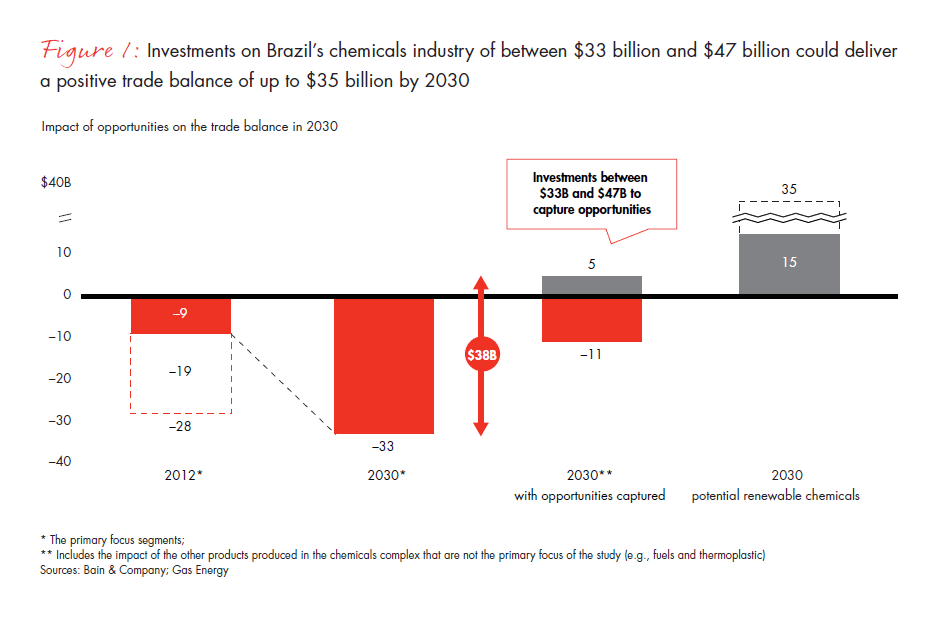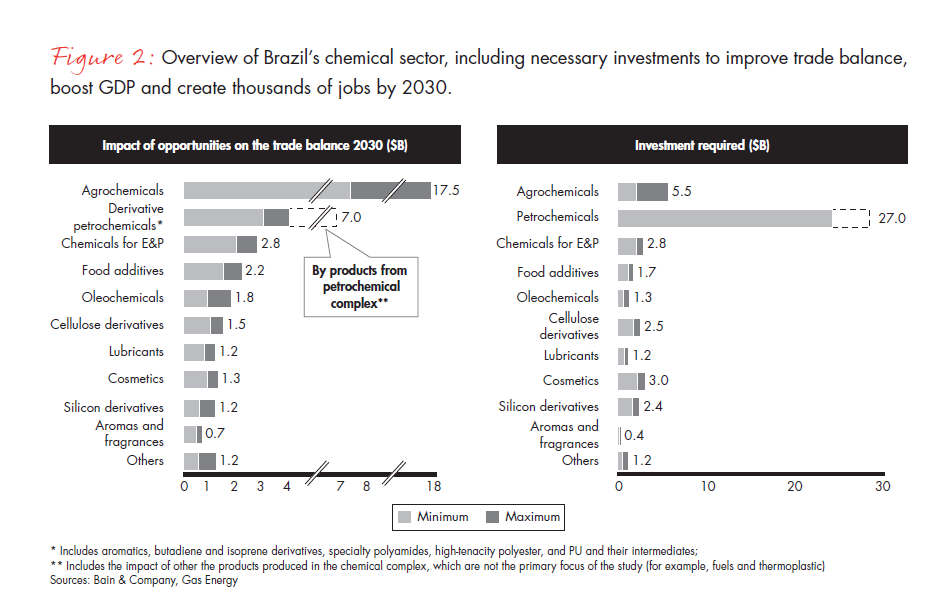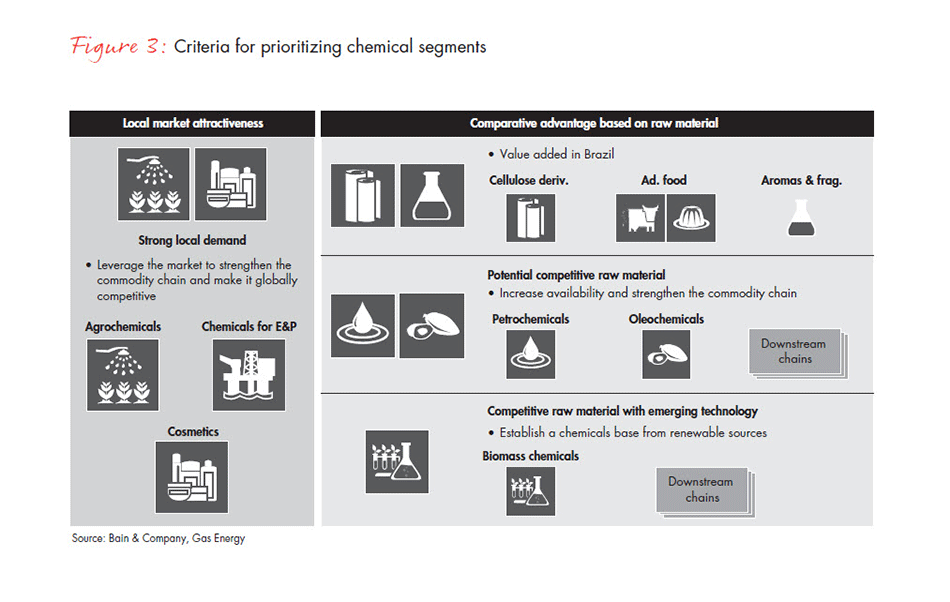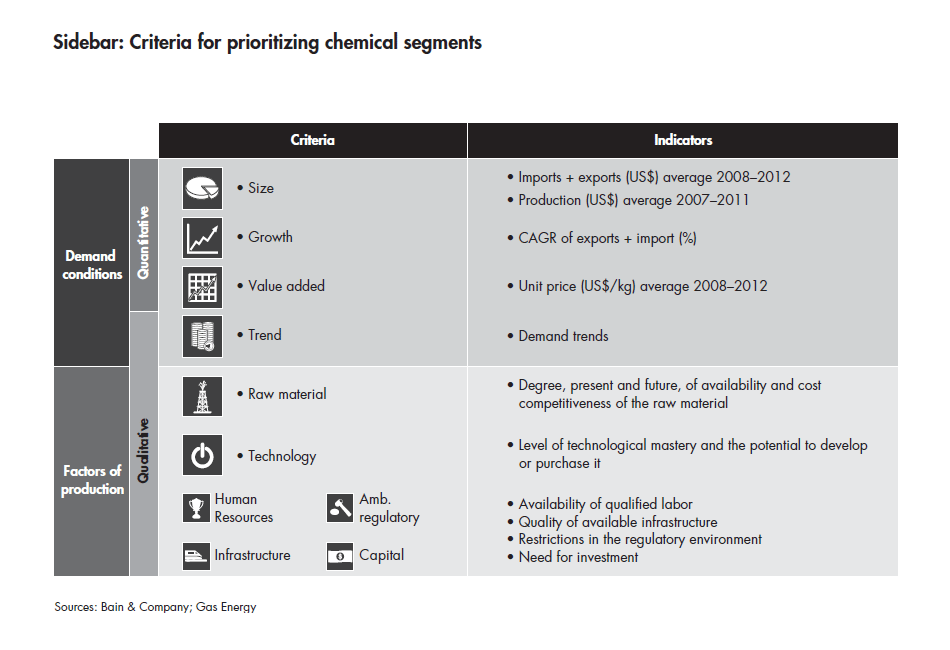Brief

Brazil’s chemical industry has grown significantly over the past 15 years and is now the sixth-largest domestic market globally, with revenue of $157 billion in 2014, or 3% of a global market of $5.2 trillion.
However, Brazil’s chemicals market has met an increasing portion of this growth with imports. Prior to 2007, the industry’s trade deficit was $6 billion to $9 billion, but by 2014, this had risen to $31.2 billion—an alarming trend. Two main factors contributed to this phenomenon:
- Domestic consumption grew quicker than production, driven by an increase of chemicals consumption per capita (as a consequence of rising income) that outstripped corresponding investments in local production capacity.
- The import of high-value chemicals grew faster than exports. Demand for them outstripped Brazilian companies’ abilities to supply them, given that they are better positioned to produce lower-value commodity chemicals.
Left unchecked, this trend could threaten the sustainability of Brazil’s chemical industry, as well as industries that depend on chemicals that are also seeing imports increase. An increase in imports of finished products often correlates with a reduction in the domestic production of the chemicals used in those products—for example, in tires, textiles and toys.
Brazil is not the only developing market to experience a severe trade deficit within its chemical industry. Mexico has faced the same issue, with net imports rising from a historical level of $7 billion to $9 billion in the early 2000s to nearly $20 billion in 2013. For 14 relevant chemicals segments in India, total net imports in 2014 amounted to 7.9 million tons, corresponding to approximately 18% of the apparent Indian consumption and a 67% increase compared with 2010.
To slow and reverse this trend, Brazil and its chemicals producers should identify opportunities to diversify the chemical industry with an emphasis on higher-value-added products, the increased integration and branching of existing commodity chains, and the development of new technologies.
In our research, we have identified several industry segments in which Brazil’s natural advantages create an opportunity to play a larger role in the global market—providing that business and policymakers can work together to reduce the competitive gaps that currently hinder investment (see sidebar). We also identified other segments in which Brazil is already competitive based on the availability of raw materials and in which it could become more competitive with further investments in new technology. These opportunities could amount to between $33 billion and $47 billion by 2030 (see Figure 1) and could reduce the trade deficit by between $22 billion and $38 billion per year over the same period (see Figure 2). The five primary focus segments with the greatest potential to improve the trade balance could generate as many as 19,000 new jobs by 2030.


Opportunities across Brazil’s chemicals industry
We classified the primary focus segments into four groups, according to the principal competitive advantage of the respective segments: strong local demand, competitive and available raw material, potential competitive raw material, and competitive raw material with emerging technology (see Figure 3).

Strong local demand
In these three chemicals segments, the local market is attractive and growing rapidly. Industry and policymakers should work together to take advantage of these opportunities to attract new, globally competitive investments and strengthen local chemicals chains.
Agrochemicals. Brazil has the largest agrochemicals market in the world, representing about 20% of the global total. Revenue in 2012 amounted to $9.7 billion, and growth ran at 16.1% between 2006 and 2012, more than twice the global average. But more than half of agrochemicals (56%) come into the country as imports because the investment environment is difficult. Registration of new agrochemicals products can take years, especially for products that are going to be produced locally. Improvements in this process could unlock significant investments in local capacity, reducing the trade deficit and benefiting the agribusiness sector with a local industry capable of supplying local agrochemicals needs faster and cheaper.
Chemicals for oil and gas exploration and production (E&P). We expect that the continuing growth in offshore drilling, particularly in the pre-salt reserves, will increase demand for chemicals used in this process. Since Brazilian regulations encourage the E&P industry to reduce harmful effects on the environment, we also expect to see an increase in the use of natural and synthetic fluids as the industry moves away from oil-based materials. Among the challenges facing chemicals companies as they begin to produce these alternative fluids are the limited availability of ethylene, the high cost of investment in local production of oleochemicals and the pricing of vegetable oils as food, not as fuel, which raises the price of the natural raw material. Policies that promote ethylene raw material availability, encourage investments in oleochemicals capacity, and create incentives for research and development (R&D) in E&P chemicals could unlock opportunities in this segment.
Cosmetics. Brazil’s cosmetics industry is the world’s third largest, with 2012 revenue of $41.8 billion, and we expect it to grow by 8.9% between 2013 and 2017. It represents nearly 10% of the global market, even though it exports only 1% of its product. The main challenge for cosmetics manufacturers is to remain competitive against other Latin American manufacturers and then take advantage of export opportunities. But producers face several specific hurdles, including limited availability and competitiveness of inputs such as propellant gas (used in aerosols) and certain petrochemical derivatives (for example, plastic packaging and surfactants), along with a complex tax regime. Moreover, local production could develop higher-value solutions with materials available in Brazil. Regulatory improvements could provide stable, sustainable and competitive access to Brazil’s diverse raw materials and attract investments in local R&D and production capacity for cosmetics.
Competitive and available raw material
A second group of chemicals are competitive based on the availability of local raw materials that producers can access affordably to add value to commodities. These producers should seek to export these higher-value chemicals.
Cellulose derivatives. Cellulose derivatives find their way into many applications, from tobacco and cosmetics to oilfield applications. Brazil is the fifth-largest market for soluble cellulose, primarily short fiber, with recorded revenue of $330 million in 2012. The principal derivatives of soluble cellulose are viscose, cellulose acetate and cellulose ethers. The chemical chain of these derivatives is characterized by insufficient local production, which leads to increasing volumes of imports. In 2012, imports of viscose yarn totaled 104,000 tons, imports of acetate grains totaled 15,000 tons, and imports of ethers totaled 32,000 tons. Local producers face high investment costs and are not competitive against well-established international producers. Research on new applications and adaptations in the type of soluble cellulose grown in Brazil (short fiber) would help spur the industry.
Food additives for animals. The Brazilian market, which registered revenue of $1.1 billion in 2012, represents approximately 10% of the global market. Between 2009 and 2012, it had an average annual growth rate of 10.1% compared with 3.7% per year for the world market. The country is the fourth-largest exporter of lysine, accounting for 19% of world exports. Total exports for the segment represented 28% of local demand in 2012. Brazil still imports all of its local demand for methionine, however, which represents 10% of the global market. To manufacture these products, the main raw materials required are sugar and propylene. Greater availability and a competitive price for propylene depend on the construction of a petrochemicals complex. The main difficulties faced by participants in this segment with local production are low availability of raw materials such as propylene at competitive prices; high cost of investment in Brazil, approximately 40% to 50% more than in other countries such as the US; and lack of incentives for research on new chemicals production routes due to a slow and bureaucratic environment for innovation.
Aromas and fragrances. The segment of aromas, flavors and fragrances is made up of high-value-added products when compared with other segments and had an average import price of $5.20 per kilo in 2012. The Brazilian market, which recorded revenue of $1.2 billion in 2012, represents approximately 5% of the global market. The market is expected to grow at an average of 6.7% annually between 2012 and 2017, higher than the 5.2% annual growth in the world market predicted for the same period. Brazil could increase production and reduce imports, given its competitive advantage and availability of raw materials such as oranges, cloves, lemons and eucalyptus oil. The main difficulties faced by companies in this sector with local production are difficulty in accessing local biodiversity due to existing regulatory restrictions, lack of incentives for R&D on alternative production routes, and the imposition of regulations on the shelf life of products currently classified as food.
Potential competitive raw material
These chemicals could be competitive with better access to local raw materials and encouragement of new investments in production capacity.
Petrochemicals. Brazil could develop a stronger petrochemical industry using the pre-salt reserves of hydrocarbons. Raw material is a fundamental factor of competitiveness in this industry, and given the production-sharing agreement model for the exploration of some large fields of the pre-salt reserves, the government will own a significant portion of the production—specifically for the Libra field, about 300,000 barrels per day of oil and 9 million cubic meters per day of natural gas by 2025. Brazil’s government could use these hydrocarbons to stimulate the petrochemicals segment, securing long-term supply at competitive cost. A competitive supply of hydrocarbons could bring investments of approximately $20 billion and will help develop several downstream chains with higher value added such as surfactants, butadiene and isoprene derivatives, aromatic derivatives, polyurethanes and its intermediaries and special polyamides.
Oleochemicals. Brazil’s oleochemical industry, which includes fats and other materials made from plants and animals, earned $660 million in 2012 and has been growing at about 23% annually. In 2012, the subsegments that had the largest effects on the Brazilian trade balance were fatty acids and alcohols, which had trade deficits of $56 million and $29 million, respectively, and glycerin, which registered a surplus of $33 million. Certain oleaginous raw materials of plant and animal origin—for example, soy, glycerin and beef tallow—show great potential, given that Brazil’s costs are competitive. Although the country currently imports palm and palm kernel oil as well as ricinoleic oil, local producers could increase production of palm and castor oil plants.
The state of Pará has 12.3 million hectares that offer ideal conditions for planting palm. By comparison, Malaysia and Indonesia, the world’s largest producers of palm, together use 8.5 million hectares for cultivating the crop. The state of Bahia shows potential for expanding the local cultivation of castor oil plants, although this would require new investments in irrigation, mechanization of production and genetic improvements to increase crop productivity. Local producers face other difficulties, including poor logistics infrastructure, high investment costs exacerbated by taxes and lack of incentives for exporting chemical products.
Brazil’s chemical industry has grown significantly over the past 15 years, but has met an increasing portion of that growth with imports. Partner Rodrigo Mas explains how this widening gap between commodity production and high-value imports threatens Brazil’s chemical industry—and a similar trade imbalance poses problems in other markets, such as Mexico and India. Chemical producers around the world should watch closely to see how Brazil’s policymakers and producers resolve this issue.
Competitive raw material with emerging technology
Access to local raw materials could make chemicals in this group competitive, provided that emerging technologies continue to develop.
Biomass chemicals. Brazil has natural advantages in the production of biomass, accounting for 30% of global production of sugarcane and 18% of soybean oil. Given this head start, the market for chemicals produced from renewable sources could represent as much as 10% of Brazil’s chemical industry by 2020.
But to get there, the industry will need to invest about $20 billion in new technologies, products and processes related to converting biomass into chemicals. Other hurdles include the small amount of resources made available through public bids and excessive bureaucracy imposed by biosafety legislation, which hampers research on genetically modified organisms (GMOs).
To attract new investments in local production, Brazil could increase incentives for R&D on chemicals made from renewable sources, with priority on the technological challenges identified in the Sectorial Technological Agenda of Renewable Chemicals. The government could also modify the approval process for GMOs and create tax exemptions on investments in the chemical industry. These changes would increase the attractiveness of investing in biorefineries that use biomass, sugarcane straw and sugarcane bagasse as inputs for chemicals. Two opportunities in particular stand out:
- Installation of an n-butanol chemical plant with capacity of 100,000 tons per year in a sugarcane area would cost about $350 million, an investment that could generate a positive impact of $240 million per year on the trade balance.
- A greenfield agriculture and a chemical plant in an agricultural frontier region could cost about $1 billion and generate a positive impact of $800 million per year on the trade balance.
Encouraging growth in the chemicals sector
With so many opportunities available in the chemical industry in Brazil, why aren’t more of them materializing?
Currently, the country is not in a competitive position to attract productive investment for most of the opportunities identified, given the regulatory hurdles that often put it at a disadvantage compared with other production sites around the world. Capturing the opportunities identified requires new policies and actions to improve the competitive conditions of the chemical industry in Brazil.
Our work with the Brazilian Development Bank (BNDES) identified six groups of competitive challenges and their respective proposed solutions:
- Sign long-term production-sharing contracts to give chemical producers access to oil and natural gas from the government’s pre-salt reserves. A competitive bidding process would identify chemical industry participants, particularly in areas of primary focus, to access hydrocarbons for conversion to chemicals.
- Streamline registration and approval processes for the production and commercialization of chemicals, especially in the agrochemicals segment. Greater agility in processing these registrations should result in the increased local production of agrochemicals, whose trade deficit reached approximately $5 billion in 2012.
- Encourage investment in agricultural and industrial segments to unlock the potential of bio-based chemicals—for example, in the construction of biorefineries close to sugarcane ethanol infrastructure and in new agricultural frontiers where agribusiness is developing new sugarcane varieties suitable for the production of biomass for the chemical industry. The segment should adopt the same logic for other possible sources of biomass for chemicals such as eucalyptus and pine pulp, orange, palm and others.
- Encourage investments in logistics infrastructure that support local chemicals commodity chains such as railways, roadways and maritime transportation.
- Increase efforts in technological innovation with strategic priority given to the primary focus segments and biomass chemicals. Although efforts in innovation are often influenced and preceded by productive investments, Brazil should target a substantial increase in R&D efforts by strengthening incentives for R&D to overcome current technological challenges. Public policies for innovation in the chemical industry should be strengthened and integrated through specific incentive programs and through the creation of a knowledge platform specifically for the chemical industry.
- Strengthen the tax system. The national and state governments should work to ensure tax equality, stable rules and selected incentives to encourage investment in the chemical industry.
Throughout this work, we’ve defined a clear strategy for Brazil’s chemical industry, based on sustainable competitive advantages in a global industry context. By leveraging its strengths, Brazil can diversify its chemical industry through investments in segments in which it can leverage the local market and raw material to become competitive. Such investments will reduce the growing trade deficit, as they strengthen Brazil’s domestic value chains rather than exporting low-value chemicals and importing higher-value ones.
Despite the challenges, examples from other markets show the effectiveness of encouraging the development and diversification of the chemical industry. For example, India developed a strong fine chemical industry (pharmaceuticals, crop protection) by promoting the development of generic alternatives to patented molecules. Investments in education and research centers fueled a supply of talented chemical engineers. In trade, the government did not create artificial protections for its industry and provided incentives for international companies to invest in fine chemicals in India.
In Mexico, the government has recently encouraged investments in the petrochemical industry to substitute for imports by providing competitive access to raw materials. A $4.5 billion petrochemicals plant jointly funded by Brazilian petrochemicals company Braskem and Mexican petrochemicals company Grupo Idesa is under development thanks to the availability of low-cost ethane.
Brazil is also taking action to spur growth in the chemical industry, including a new biodiversity law that aims to reduce bureaucracy and allow greater access for scientific research and commercial application of the country’s native plants, animals, microbes and other genetic materials. The government is also updating its rules on chemicals used for crop protection (including pesticides and herbicides) to stimulate that industry.
Finally, BNDES and the Funding Authority for Studies and Projects (a development agency of the Ministry of Science, Technology and Innovation) are granting 2.2 billion Brazilian reals (about $530 million) for innovation in chemicals, specifically in the areas of food additives for animals, silicon derivatives, carbon fiber, chemicals for exploration and production of oil, prime materials for cosmetics, and chemicals obtained from renewable sources.
The recommendations and opportunities described for Brazil demonstrate how a national chemicals strategy can be developed that reflects both the attractiveness of markets and a country’s source of advantage. Chemicals companies around the world should monitor the sector’s progress in Brazil, since much of what is under way there can be replicated in other places.
How we identified opportunities in the sector
The findings in this brief are based on a study that Bain & Company conducted for the Brazilian Development Bank (BNDES) between May 2013 and November 2014. The study identified and ranked 66 segments of the chemical industry, based on Brazil’s potential competitiveness in each of them. It prioritized 21 segments that accounted for $8.9 billion of Brazil’s trade deficit in 2012 based on demand conditions and factors of production (see Figure). Then, we analyzed each of the 21 segments in further detail and identified investment opportunities for each of them, along with industrial policies that would help unlock these investments. You can find the study online at BNDES’s website, as part of its mandate to contribute to social and economic development in Brazil.
To gain a better understanding of Brazil’s chemicals sector, we first defined its segments, based on a thorough analysis of the value chains. We then looked at each segment’s competitiveness based on four dimensions: demand trends, competitiveness in production, industry dynamics and the level of development of complementary industries. We also considered industrial policies in other developing countries and the participation of the business community, which we engaged in more than 100 interviews and several workshops. Together, these inputs helped us identify the chemical segments with the highest potential to grow in Brazil and reverse the sector’s trade deficit.

Rodrigo Mas, José de Sá and Fernando Martins are partners with Bain & Company in São Paulo. Mark Porter is a partner in Bain’s London office. All four work with the firm’s Global Chemicals practice, and Mark leads the practice in Europe, the Middle East and Africa.
The authors would like to thank Daniel Becker, a principal in Bain’s São Paulo office, Daniel Chebat, a manager in Bain’s São Paulo office, and Felipe Coelho, a manager in Bain’s Rio de Janeiro office, for their contributions to this report.



